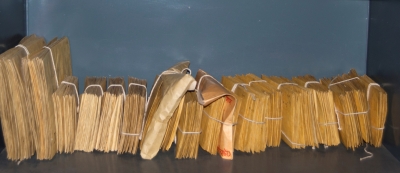
The foundation of modern Nepal, which until 2007 was styled as the 'only Hindu kingdom (of the world)', goes back to the middle of the 18th century when Pṛthvīnārāyaṇa Śāha, king of Gorkha, started expanding his dominion. He and his successors conquered many petty states, such as, in 1768/69, the rich Malla kingdoms of Kathmandu Valley, and soon ruled over a large territory, which subsequently developed into a nation state.
As a result of its territorial expansion and emergence as a nation state, Nepal experienced a rapid and extensive increase in the deeds and other documents produced in it in the 18th and 19th centuries. Within the state administration, in temples, in the execution of law and in economic life, textualization reached unprecedented levels.
The project "Documents on the History of Religion and Law of Pre-modern Nepal" aims at investigating the country’s rich textual material, consisting of historic temple documents and administrative and legal documents. It wishes, among other things, to understand developments entailed by the formation of the Himalayan state, such as the restructuring of social institutions and the expansion of Hindu rule. With research units in Heidelberg and Patan, Nepal, the project will study this unique textual corpus systematically; it will also make selected documents accessible in digital scholarly text editions, accompanied by translations.
The centrepiece of the academic endeavour is the creation of a digital open access database, a pioneering work within research on South Asian documents. This database will unite references to both edited and published documents and unpublished ones, and will enable complex searches within the data sets. Moreover, the research based on the textual corpus will connect to wider scholarly discussions on, for example, the legitimation and affirmation of rulership, political unification and nation building, the importance of the textualization and codification of law, and the development of elite cultures in the 19th century. This will help to form a more nuanced picture of Nepal’s socio-cultural transformations between the late 18th and first half of the 20th century.
Research Material
The research is based on a corpus of documents available in public and private archives of the Kathmandu Valley. Many documents held by the National Archives of Nepal and other governmental institutions were microfilmed by the German Oriental Society (Deutsche Morgenländische Gesellschaft) as part of the Nepal-German Manuscript Preservation Project (NGMPP; its successor being the NGMCP). However, only very few documents have so far been edited, translated, or studied. Based on a bilateral agreement between His Majesty’s Government of Nepal and the Federal Republic of Germany, copies of the microfilms are stored in the National Archives of Nepal and in the Oriental Department of the Berlin State Library (Staatsbibliothek zu Berlin, SBB). The current project, in close cooperation with these institutions, aims to successively catalogue and digitize NGMPP material, consisting of over one hundred thousand historical documents that had previously been explicitly closed off to cataloguing initiatives. Thus the project will make a substantial contribution to the preservation of what for South Asia is doubtless a unique microfilm collection.

In addition to the documents microfilmed by the NGMPP, documents from other collections will be included over time (e.g., Asha Archive, Kathmandu; Hodgson Collection, London).
The corpus is particularly wide-ranging, covering temple documents and legal documents of different kinds, among which particularly well represented are those relating to religious institutions (such as edicts, land grants, contracts, foundation charters, and letters) and to legal and administrative practice (such as caste regulations and court decisions on moral conduct). Not only will the corpus be catalogued, but its content will also be made accessible through search functions. Early findings already show the potential value of the Nepali documents for furnishing fields of study for future generations of researchers. The temporal focus of the current project is on the early Śāha (1769-1846) and Rāṇā (1846-1951) periods, i.e., on Nepal's ‘long 19th century’.
Research
The corpus has great potential to give rise to questions of a philological and broader cultural nature. In exploring the extensive thematic spectrum of the documents, the members of the project focus on specific topics related to their background and areas of research, including elite cultures, the development of a public order and public administration, legal practices, deities and religious rituals, festivals, or temples and other religious sites. For the topics, see Research Topics.

